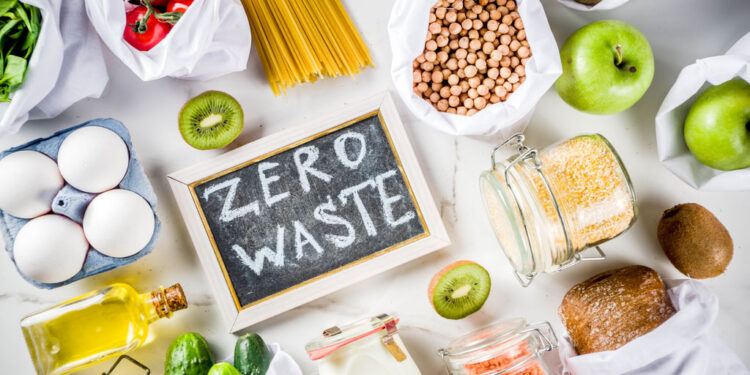For a society living in the twenty-first century that’s currently also fighting this century’s pandemic, words like “reduce”, “reuse”, or “recycle”, are becoming vernacular. Along with “refuse” and “rot” they are becoming more common. We hear them on the news. We see them on social media and bump into them in the grocery stores. That mantra makes up the guidelines for waste management towards decreasing our waste and carbon footprint.
We live in a time when environmental awareness is becoming a trend that lasts for more than one season. With each new economic sector becoming more sustainable through its products, agenda, or target market, the environment is finally receiving at least part of the attention it deserves. Terms like “reduce”, “reuse”, “recycle”, “sustainable”, “eco-friendly”, “green” are familiar, and “refuse” and “rot” are following their footsteps. We know them but do we understand their purpose thoroughly?
The five words mentioned above, the 5 R’s of the waste hierarchy, don’t only work as reminders for those actions. The order in which they are used together matters as well. The problem is that most of us focus too much on the second to last word – “recycle”. There is a reason why “recycle” isn’t the first word in this mantra. Recycling is meant to be among the last actions we take, the last resort we apply to decrease the amount of waste we have to manage. However, we only hear of recycling across the country and the world. That’s why it is a hierarchy represented through a pyramid to remind people.
The Waste Hierarchy

When you think of a hierarchy in the business world, you see a pyramid with an upwards pointing tip. The waste hierarchy goes the other way around. Aside from its upside-down position, the hierarchy follows the same principles as any other hierarchy. The thickest part of the pyramid is where the most amount goes and the thinnest is where the least amount is.
As the image above shows, most should be refused, then we reduce, reuse, recycle and rot. So before we recycle and rot our waste, we should refuse it, reduce it, or reuse it. However, we don’t focus as much on anything other than recycling. Most of us collect our waste selectively. We collect paper, cans, plastic containers, and glass bottles separately. We want them all recycled, and we think we’ve done our duty to the environment. The problem is that a lot of our “recyclable” waste is made out of plastic, and plastic comes in many different types. Out of all the types of plastic that we use, only two types of single-use plastic can be recycled usefully: Polyethylene terephthalate (PET) and high-density polyethylene, also known as plastic #1, and plastic #2.
Currently, as it happens, the US only recycles 9% of containers. Everything else that is made out of plastic ends up in the dump. While we can strive for a more proficient waste recycling system in the future, ways to reuse single-use plastics, we need to relearn the waste hierarchy. These 5 R’s are in the set order because they guide the principles we should follow to reduce our waste output. Let’s see why they have this order and how we can use it accordingly.
Refuse

The first principle of waste reduction is to refuse it. Whenever you can, which is most of the time, say no to single-use plastic. Say no to anything that you don’t need. Say no to a new purchase that’s not a necessity. Say no to impulse purchases. Just use what you already have if the new item is not necessary for your life. It doesn’t matter if it’s free. If you don’t need it, refuse it.
The simplest way to apply this principle is to refuse single-use items. When you go grocery shopping, have a reusable bag with you. A cloth bag that you can store in a pocket, purse, laptop bag, bike, or car is convenient for any situation. They provide plenty of storage space and occupy very little space. When you buy your morning coffee, instead of the single-use cup that you get, which contains PFAS chemicals, tell the barista to use your reusable coffee cup instead. Refuse single-use utensils when you order in. Try cooking your own food if possible and refuse the food containers as well. It doesn’t matter if they are all free. You will only use them once, and then, they become waste.
Reduce

The principle of refusing is similar to reducing. They both focus on limiting the amount of waste we use. If by refusing, we decline its use, by reducing, we decrease its use. We focus on doing the same thing in different ways. If we can not apply the first principle, the second principle can work. We cut down on what we use to what we need to use—making choices that result in reducing the things we use will decrease waste.
We can apply the reducing principle by decreasing the number of things we purchase. At the same time, we can donate or sell items we no longer use or need. Living in a consumerist market means that we have been brainwashed to consume more or at least buy more. When we go to the store, we see a lot of items that are cheaper if we buy them in bulk. But do we actually need more of a specific item, or does one purple shirt suffice? A great way to reduce your consumption is by rethinking how you consume things through KonMari. Whether they are electronics, plates, clothes, or apples, reducing the number of items we purchase to what we need and not what we want can go a long way to limit waste. Instead of buying TVs for every room, only purchase the amount required for entertainment areas. If you have a set of 6 to 10 dishes for your tableware, that’s enough. The same goes for glasses, cutlery, and other kitchen essentials that we can reduce as well. Try to implement a rule to limit purchasing new things by waiting a while before buying. Another option is to replace something you already have when you are no longer using it with a new one. Buy something new to replace something old. This principle of reducing is meant to be applied to all resources, meaning water and energy consumption as our modern lifestyle is draining our planet’s resources.
Reuse

We aim to decrease the amount of waste we generate, and the most straightforward way is to stop creating it. That means that instead of purchasing something only to throw it away in a short period of time, we use something that we can use for a longer period of time. Looking at how we use plastic should tell us enough. Most of the non-alcoholic drinks we buy at the store come in plastic bottles, food containers are made out of plastic, many items we purchase come wrapped in plastic, and the famous plastic straw is renowned for a reason. All these products can live without plastic, and we can drink anything without a straw. So instead of buying things that come in plastic containers, let’s not do that when we can.
You don’t need to buy yet another bottle of water if you have a reusable bottle. You can squeeze your orange juice in a glass bottle just as well. Anything made out of metal or glass can replace plastic for storing purposes. Metal, glass, and wood are used for straws. Glass jars are ideal for making your own pickles and storing them for winter or as food containers in your cupboard. Many things that we already own can be repurposed to extend their life. Anything made out of wood, metal, or glass can be refurbished, and if you’re not sure, take a look at chandeliers made out of bottles. Giving things away to friends and family that might find use in them is another way to reuse items. Donating items, clothes, or electronics to charity will improve the lives of those less fortunate and further extend their life cycle.
Recycle

When we can not refuse, reduce, or reuse something, only then should we recycle. But … and I can’t be stressing this enough, only if we can not apply the other principles. Through recycling, the material used for the item we no longer use is reduced to its most basic state and converted into something else. This principle shouldn’t be our go-to principle because the recycling process requires energy and resources. Additionally, all these materials, especially plastic or plastic-based materials, can only be recycled a limited number of times before their quality is gone.
Around 90% of the world’s plastic is not recycled. The estimations say that we have produced approximately 8.3 billion metric tons of plastic so far, and of that, 6.3 billion metric tons became waste. Much of that plastic ends up in landfills or natural water sources, and because of that, our oceans have five plastic concentration zones in offshore ocean waters. The biggest of these plastic concentration zones is between California and Hawaii, known as the Great Pacific Garbage Patch (GPGP). Spreading over 620,000 square miles in size, it’s almost three times the size of France, the country. The weight of that plastic is 80,000 metric tons. There are four other such zones for the remaining plastic in our oceans. This is why we should do everything else before we turn to recycling, and when we have to recycle, check the types of materials that can be recycled at your local recycler.
Rot

The reason why rot is last is that this waste principle refers to degradation. You might have noticed that all of the above principles make no reference to organic materials that degrade biologically in the environment. That’s because the materials and most of the products mentioned above do not rot. While paper is an organic material, not all types of paper can be absorbed back by the planet’s environment. Rot is last on the waste hierarchy, meaning that we should recycle paper before it rots. There are types of paper infused with chemicals, which can be toxic.
The materials that do degrade in the environment are those that we can use to compost. Any kind of organic yard waste or food scraps enters into this category. Paper that is wet, dirty, or has food residue (not to-go food containers) is composted. Your plants will love some of the minerals left in your coffee ground, so compost that as well. You can do this yourself in a garden or tightly sealed compost container, or contact your local recycler for more information.
Additional R’s

While not as commonly used, the following R’s are just as applicable for those seeking to live a sustainable lifestyle. “Repair” underlines the fact that something that is broken or no longer in its best shape, can be repaired to have a longer life expectancy and use. The second R stands for “Rethink” because we all have to learn to rethink our way of consumption. Through books like KonMari, you can understand a new way of thinking about your possessions and you can change how you use them. The concept of “bigger is better” is unsustainable and we should aim for sustainability in the face of the challenge our planet is struggling with. “Less is more” is the mantra that’s trending and we can see that even in interior designs of 2022. Lastly, we have “Refill” that hints at not only using refillable containers but also at using refillable stores. You may have to look for them but there are chances that you will find them in your city. These stores only sell the contents of the products, whether they be rice, flour, other ingredients, or shampoos and detergents. Like this, we will decrease the number of plastic bottles, containers, or boxes that we purchase with each product and refill them instead.
Conclusion
As we start the new year, we should look back at what we learned in the last one. Our world is suffering, and we can see it through every season, every storm, heatwave, or flood. Plastic is the most used material on the planet, and many of the things that we buy contain it, not only in their wrap. The composition of this material makes it so easy to shape into anything, and we implemented it in literally everything. The planet is overflowing in it, and we need to stop making any more of it. We could use so many alternatives that have a much lower carbon footprint on our environment. Let’s motivate more sectors of the economy to change their practices because an environmentally-conscious consumer isn’t only an eco-friendly consumer but also an economically sound consumer.
The principles presented in this article are to be followed in that order, and recycling should be one of the last things we do. Unfortunately, we all jump up to recycle but fail at anything above that. The waste hierarchy has both rhyme and reason so let’s try to maintain the tune. Let us know in the comments before if you have any questions about these principles. Like & Share this article with your friends, and together we can start applying the 5 R’s of waste management.











